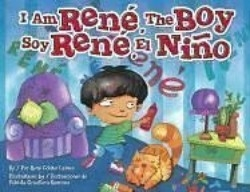Soy Rene; El Nino (I am Rene The Boy)
“In El Salvador, I was René the brave, René the strong and René the funny. I cannot believe it. Here, in the United States, René is a girl’s name.” Embarrassed by the teasing from the kids at his new school, René proactively checks a book out from the library called The Meaning of Names. “René” means “reborn,” and the boy embraces its meaning.
An opportunity presents itself, and René writes an incredible essay about his name, its meaning, and others who share his name, like the philosopher René Descartes. “In English, I found René in my favorite color, green. René is written backwards in energy. I have a lot of energy. I can find René in what I like the most, adventures!” Not only does he win the essay contest, but René decides to share the prize with his class. Now his once teasing classmates love him for his name, his writing ability, and of course for sharing his prize two extra-large pizzas.
Like his protagonist, the author hails from El Salvador, and wrote this book based on his own immigration experience. Names are an important part of people’s identities, and Laínez expresses the cultural importance of some names in this book. An elementary school teacher, Laínez graduated from California State University at Northridge and received a Master’s at Vermont College. His previous children’s books are El Juego de Lotería / Playing Lotería and Waiting for Papa / Esperando a Papá.
The illustrator was born in Mexico City; she has provided art for sixteen picture books, has worked for several publishers and magazines, and has displayed her work in collective exhibits in Mexico and Spain. Ramírez uses watercolor in a skillful way to show certain textures in the images. She uses pattern on the wall and contrasting shades of blue and green to distinguish walls and floor. Highlights in the characters’ hair add depth and bring life to the images. Although the illustrations are cartoonish, readers who look closely will see real people in real situations.
Soy René, El Niño speaks clearly to children ages five to eight. The author wrote both the English text, which is displayed on the top of each page, and the Spanish text below. He manages to make even tricky plays on words—like the acronyms that René makes with his name—work well in both languages. This book unmistakably expresses the adventure René embarks on, discovering his self-identity while ultimately finding great pride in his name. The title, a bit misleading, seems to simplify the actual content within the book’s pages, which is worthwhile.
Disclosure: This article is not an endorsement, but a review. The publisher of this book provided free copies of the book to have their book reviewed by a professional reviewer. No fee was paid by the publisher for this review. Foreword Reviews only recommends books that we love. Foreword Magazine, Inc. is disclosing this in accordance with the Federal Trade Commission’s 16 CFR, Part 255.

